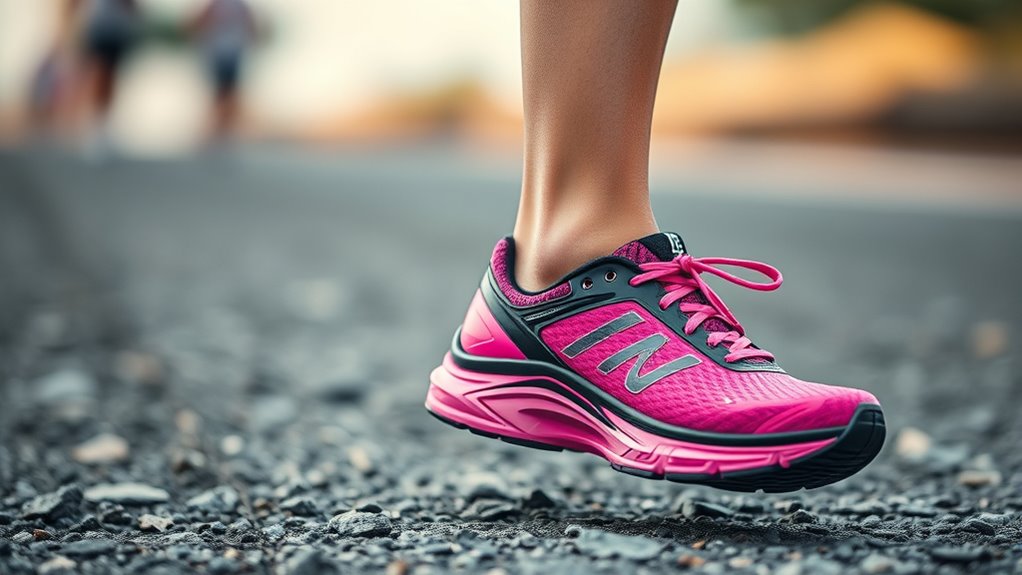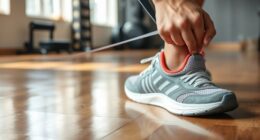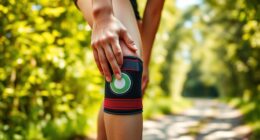If you’re looking for the best pronation-control shoes in 2025, I recommend the Brooks Adrenaline GTS 24 for targeted support, the Brooks Ghost Max 2 for cushioning and style, the New Balance W1540 v3 for long-distance stability, and the New Balance 860 V14 for plush comfort and durability. These shoes balance comfort, support, and stability, making every step secure. Keep exploring to discover more about each shoe’s features and find the perfect fit for your running needs.
Key Takeaways
- Top recommended shoes combine stability, cushioning, and durability to support overpronating female runners effectively.
- Features like medial posts, reinforced midsoles, and structured heel counters enhance pronation control.
- Breathable mesh uppers and moisture-wicking linings improve comfort and foot health during long runs.
- Prioritize proper fit, wide toe boxes, and high-quality materials for sustained support and injury prevention.
- Popular options include Brooks Adrenaline GTS 24, Brooks Ghost Max 2, New Balance W1540 v3, and New Balance 860 V14.
Brooks Women’s Adrenaline GTS 24 Supportive Running Shoe
If you’re a female runner with pronation issues, the Brooks Women’s Adrenaline GTS 24 is an excellent choice because it offers targeted stability and support to control overpronation. I find these shoes incredibly comfortable, especially around the ankle and toes, with a soft mesh that wraps snugly without causing pain. They fit true to size, though I sometimes go half a size up to prevent rubbing, and the wide options help for a better fit. Designed mainly for indoor use, they’re durable enough for treadmill runs and gym workouts. Overall, they provide excellent support, making them a reliable choice for high-mileage runners needing stability and comfort.
Best For: women who need supportive, comfortable running shoes with stability features, especially those with pronation issues or foot conditions like bunions or plantar fasciitis.
Pros:
- Provides targeted support and stability, ideal for overpronation control and high-mileage running.
- Soft mesh upper offers a snug, pain-free fit, accommodating sensitive toes and bunions.
- Durable enough for treadmill and gym use, with a stylish appearance and lightweight design.
Cons:
- May wear out faster when used extensively on outdoor cement surfaces.
- Slightly higher price point, which might be a consideration for budget-conscious buyers.
- Some users may need to go half a size up to prevent rubbing or discomfort.
Brooks Women’s Ghost Max 2 Neutral Running & Walking Shoe
The Brooks Women’s Ghost Max 2 is an excellent choice for female runners seeking a neutral shoe with superior cushioning and support. It offers plush padding that absorbs shock and reduces joint soreness, making it perfect for running, walking, or long shifts. The wide toe box comfortably fits bunions and foot issues, while the breathable upper keeps feet cool. Lightweight and easy to break in, these shoes provide immediate comfort. Durable and well-made, they maintain support over time. Though slightly heavy initially, they become very comfortable with use. Stylish and versatile, the Ghost Max 2 is a reliable option for those looking for support, comfort, and style.
Best For: women seeking a comfortable, supportive, and stylish neutral running and walking shoe suitable for long hours, foot conditions, and various activities.
Pros:
- Exceptional cushioning and shock absorption for reduced joint and foot fatigue
- Wide toe box accommodates bunions and foot issues comfortably
- Durable, lightweight, and stylish design suitable for everyday wear and multiple activities
Cons:
- Slightly heavy initially, which may require an adjustment period
- Feet may slide outward on uneven terrain or thick grass
- Might not fit well with certain foot braces or require size adjustments
New Balance W1540 Version 3 Womens Running Shoe
The New Balance W1540 Version 3 Womens Running Shoe stands out as an excellent choice for female runners seeking stability and support during long-distance runs. Designed with ENCAP and Rollbar midsole technology, it offers superior motion control and helps maintain proper form. Although it’s no longer produced in the U.S. since 2021, its durable construction and focus on support make it a reliable option. Built for runners aiming beyond 5K, this shoe emphasizes research-driven design over branding, ensuring a comfortable, stable ride. If you need dependable pronation control for your longer runs, the W1540v3 remains a solid choice.
Best For: female runners seeking long-distance stability and support, especially those needing effective pronation control during runs beyond 5K.
Pros:
- Provides excellent support and stability with ENCAP and Rollbar midsole technology
- Designed specifically for long-distance runners who require motion control
- Durable construction suitable for high-mileage training
Cons:
- No longer produced in the United States as of 2021, which may affect availability
- Might be less cushioned compared to newer, lightweight models
- Limited color and style options due to discontinued production
New Balance Womens Fresh Foam X 860 V14 Running Shoe
Designed specifically for female runners who need extra stability, the New Balance Womens Fresh Foam X 860 V14 Running Shoe offers reliable support and plush cushioning. It features Fresh Foam X cushioning, delivering exceptional underfoot comfort, while Stability Plane technology enhances stability during your runs. Built with durability and support in mind, it performs consistently across various terrains and distances. This shoe balances innovative stability features with soft cushioning, making it perfect for daily training or long-distance runs. If you’re seeking a dependable, comfortable shoe that can handle diverse conditions, the 860 V14 is a solid choice to keep you supported every step of the way.
Best For: women seeking a reliable, stable, and comfortable running shoe capable of handling diverse distances and terrains.
Pros:
- Provides excellent stability with Stability Plane technology.
- Plush Fresh Foam X cushioning offers superior comfort.
- Durable construction suitable for various terrains and long-distance runs.
Cons:
- May be heavier than minimalist running shoes.
- Slightly higher price point compared to basic running shoes.
- Designed primarily for stability, which may not suit overpronators requiring specialized support.
Factors to Consider When Choosing Pronation‑Control Shoes for Female Runners

When choosing pronation-control shoes, I focus on finding a proper fit and size to guarantee comfort during runs. I also look for supportive cushioning, stability features, and breathable materials that enhance performance and prevent injuries. Considering durability and material quality helps me select shoes that will last through regular use.
Proper Fit and Size
Choosing the right fit and size is essential for effective pronation control in female running shoes. A proper fit guarantees the shoe offers adequate support without causing discomfort or rubbing, which is key for managing pronation. Shoes should be true to size, though some runners prefer half a size larger to accommodate swelling and prevent tightness. A wide toe box allows natural toe splay, reducing pressure that could interfere with proper pronation. The heel counter must fit snugly to stabilize the rear foot and prevent excessive movement that can worsen pronation issues. When shoes fit correctly, they help maintain proper foot alignment, reducing injury risk and improving overall running efficiency. Prioritize a secure, comfortable fit to get the most out of your pronation-control shoes.
Supportive Cushioning Features
Supportive cushioning plays a vital role in pronation-control shoes by absorbing shock and reducing impact stress on your joints during runs or walks. Proper cushioning provides a plush underfoot feel while maintaining stability, which is essential for managing overpronation. Advanced technologies like Fresh Foam X or specialized foam midsoles boost comfort without compromising support. These cushioning features often work together with motion control elements to guide your foot through proper biomechanics. Finding the right balance of support and cushioning can prevent fatigue and discomfort, especially if you have flat feet or low arches. By prioritizing cushioning that absorbs shock and offers a stable yet comfortable ride, you can enjoy a smoother, more supportive running experience that helps keep your joints protected mile after mile.
Stability for Overpronation
For female runners with overpronation, stability features in pronation-control shoes are essential to maintain proper gait and reduce injury risk. Medial posts and reinforced midsoles work together to curb excessive inward rolling, providing vital support where it’s needed most. A wider base and firm midsole construction enhance balance, preventing the foot from collapsing inward during each step. Proper arch support and advanced motion control technologies help align the foot more neutrally, reducing strain on joints and tissues. Additionally, a structured heel counter offers extra stability, limiting unwanted foot movement. Consistently wearing shoes with these stability features can improve gait mechanics over time, lowering the chances of common overuse injuries like plantar fasciitis and runner’s knee. Choosing the right stability elements is key to a safer, more efficient run.
Breathability and Comfort
When selecting pronation-control shoes for female runners, breathability and comfort should be top priorities to guarantee a pleasant and effective running experience. Breathable materials like mesh uppers help keep your feet cool and dry during long runs, reducing discomfort from sweating. Proper ventilation prevents overheating, which can lead to blisters and foot fatigue. A soft, snug fit that accommodates foot swelling without constriction enhances overall comfort, especially over extended distances. Moisture-wicking linings and perforations boost airflow and help maintain a dry environment inside the shoe, essential for foot health. Shoes with breathable construction also lower the risk of fungal infections and skin irritation, making them a practical choice for those who value both comfort and foot well-being during every run.
Durability and Material Quality
Choosing durable pronation-control shoes means paying close attention to the quality of materials and construction, as these factors directly impact how well the shoes hold up over time. High-quality shoes often feature reinforced midsoles and tough outsoles made from durable rubber, designed to resist wear from frequent use. Premium foams like EVA or specialized stability foam improve shock absorption and extend the shoe’s lifespan. Well-made shoes also include sturdy stitching and reinforced toe caps to prevent material breakdown in high-stress areas. Additionally, durable uppers crafted from breathable, tear-resistant mesh or synthetic fabrics help maintain structural integrity during long runs. Overall, investing in well-constructed shoes ensures consistent support, cushioning, and longevity, making them a reliable choice for serious female runners.
Suitable for Medical Needs
Selecting pronation-control shoes that meet medical needs involves understanding the specific support features required for conditions like flat feet, plantar fasciitis, or overpronation. These shoes are designed to limit inward foot roll, providing essential stability and preventing injury. Properly fitted options offer extra arch support and firm midsoles to alleviate pain and reduce stress on joints caused by abnormal mechanics. Medical professionals often recommend these shoes for women with diagnosed overpronation or those recovering from foot, ankle, or knee injuries, as they promote correct alignment during activity. The stability features, such as medial posts and supportive materials, are tailored to address individual medical needs. Choosing a pair with the right level of motion control helps manage conditions effectively while ensuring comfort and minimizing the risk of further injury.
Frequently Asked Questions
How Do I Know if I Need Pronation-Control Shoes?
If you’re overpronating, you’ll notice your feet rolling inward excessively when you run, which can cause pain or discomfort. I recommend checking with a specialist or getting a gait analysis—many stores offer this for free. If they confirm overpronation, then pronation-control shoes are a smart choice. They provide the extra support needed to keep your feet stable, prevent injuries, and make your runs more comfortable.
Can Pronation-Control Shoes Help Prevent Running Injuries?
Did you know that over 70% of running injuries are linked to improper foot mechanics? Pronation-control shoes can definitely help prevent injuries by providing extra support and stability, especially if you overpronate. I’ve seen many runners reduce their injury risk and improve comfort by switching to these shoes. They help align your foot and ankle, decreasing strain and allowing you to run with less pain and more confidence.
Are Pronation-Control Shoes Suitable for Overpronators?
Yes, pronation-control shoes are suitable for overpronators. I’ve found they provide the necessary stability and support to prevent my ankles from rolling inward too much. These shoes help align my foot properly, reducing strain on my knees and hips. If you overpronate, investing in good pronation-control shoes can make a real difference in comfort and injury prevention. Just make sure to choose a pair that fits well and suits your running style.
How Often Should I Replace My Pronation-Control Running Shoes?
Many believe running shoes last forever, but I recommend replacing your pronation-control shoes every 300 to 500 miles. Over time, the cushioning and support break down, which can lead to discomfort or injury. If you notice decreased support, unusual aches, or visible wear, it’s a sign to swap them out sooner. Regularly checking the tread and cushioning helps make certain you stay comfortable and injury-free with each run.
Do Pronation-Control Shoes Affect Running Speed or Performance?
Yes, pronation-control shoes can impact your running speed and performance. I’ve found that they provide better stability, reduce fatigue, and help maintain proper alignment, which often leads to more efficient running. When I wear the right pair, I notice increased comfort and less energy spent on correcting imbalances. However, it’s essential to choose shoes that fit well and suit your gait to truly boost your performance.
Conclusion
Choosing the right pronation-control shoe can make all the difference in your running experience. Did you know that over 60% of female runners experience overpronation? Investing in supportive footwear not only helps prevent injuries but also boosts your confidence with every stride. Whether you prefer the stability of Brooks or the cushioning of New Balance, finding the perfect fit means you’re more likely to enjoy consistent, pain-free runs. Ready to hit the pavement with support that works for you?














